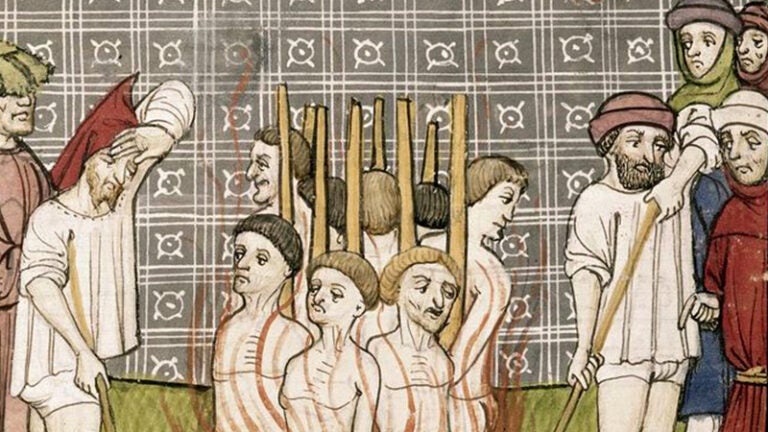
Conference explores ‘Conspiracies Then and Now’
They’ve garnered considerable media coverage of late, but conspiracy theories are nothing new: they’ve grabbed people’s attention throughout history.
Residents of ancient Rome spread conspiracy theories by scratching graffiti on the city walls. In 1307, medieval French King Philip the Fair used them to sink the powerful Knights Templar by unleashing a storm of salacious — and untrue — rumors.
In the 17th century, mass accusations of witchcraft resulted in the execution of 19 following the Salem Witch Trials. In the 20th century, the assassination of President John F. Kennedy and the Apollo moon landings gave rise to numerous conspiracy theories.
Today we grapple with ones such as QAnon — a conspiracy theory spreading on social media that many fear contributes to the undermining of democracy.
USC Dornsife College of Letters, Arts and Sciences’ online conference “Conspiracies Then and Now” will explore the history of conspiracy theories dating back to the Middle Ages and draw parallels with contemporary beliefs.
Held March 18-19 and sponsored by USC Dornsife’s Center for the Political Future (CPF) and Center for the Premodern World (CPW), in partnership with the Rancho Mirage Writers’ Festival, the conference will also discuss how conspiracy theories have influenced recent political messaging.
The conference will feature 20 experts participating in panel discussions on such topics as heresy, social media, anti-Semitism, the Templars and the Deep State, millennial cults, and QAnon.
Among the scholars taking part are USC Dornsife’s Jay Rubenstein, professor of history and director of the CPW; Bob Shrum, Carmen H. and Louis Warschaw Chair in Practical Politics, professor of the practice of political science and director of the CPF; Mike Murphy, co-director, of the CPF; Norbert Schwarz, Provost Professor of Psychology and Marketing; and Steve Ross, professor of history.
Rubenstein was inspired to organize a conference on conspiracy theories with the CPF after reading about QAnon, which believes that a group of Satanic, cannibalistic pedophiles are running a global sex-trafficking ring.
“As I read, I thought, ‘I’ve heard a lot of these ideas before in the 12th- and 13th-century playbook — Jewish cabals controlling finances, children being sacrificed, vast conspiratorial movements to control power, with the expectation that a messianic figure will appear to make everything okay,’” he said.
Rubenstein and Shrum agree that many parallels can be drawn between medieval conspiracy theories and those that flourish online today, noting that some recent conspiracists have adopted concepts from the Middle Ages to advance their agenda. For example, medieval prophets believed that a Jewish-born anti-Christ would seize control of world events through nefarious means, much like QAnon believers today imagine Hungarian-born American billionaire investor and philanthropist George Soros is manipulating world events.
Here the two USC Dornsife scholars answer five questions about conspiracy theories.
What do people find so attractive about conspiracy theories?
SHRUM: Conspiracy theories salve people’s hurt, they reinforce preconceived biases and, in some cases, they serve either their economic interests or their ideologies.
RUBENSTEIN: It’s a way of making sense of the world, suggesting that — for better or worse — someone is in control and if we could only pull back the curtain and see what’s going on, then we can get a handle on the world. That’s an appealing idea to many people.
How did conspiracy theories spread before the advent of the internet, social media and cable television?
RUBENSTEIN: Much of it was spread by word of mouth. I think there’s an interesting comparison to be made between the way bad ideas travel on social media and the internet and the way they did in the Middle Ages, when editing processes and information filters were also not that strong. You would pull a book off the monastic shelf and the very fact that something was written down in a book invested it with authority.
Are the Middle Ages and the current era particularly important periods for conspiracy theories? Or are there other periods in history when they were also prevalent?
RUBENSTEIN: The 13th-century was the golden age for medieval conspiracies. The Crusading movement is in disarray, the Church is failing to live up to its ideals, Frederick II, the Holy Roman Emperor, is widely suspected of being the anti-Christ, Italian prophet Joachim of Fiore is predicting the world will end in 1260 — there’s lots of fertile ground here for conspiratorial thought. But there are other periods, too, the French Revolution, for instance. I think conspiracy theories tend to flourish during times when massive social change occurs simultaneously with a revolution in the means of producing and recording knowledge.
Why have conspiracy theories spread in recent times?
SHRUM: The rise of social media means that the capacity to spread conspiracy theories has now become hyper-charged. We’ve lost a lot of the filters that gave us a common knowledge base. John Kennedy and Richard Nixon could disagree about whether or not we should have a program called Medicare, but they disagreed on the basis of the same set of facts. The problem is that now people don’t feel any need to pay attention to any media outlet — or indeed any source of facts — that tells them something they don’t want to hear.
How dangerous do you think conspiracy theories are? And how should we combat them?
RUBENSTEIN: Never underestimate the power of a bad idea. Conspiracies are dangerous because their failure seems ultimately to confirm their existence. Combating them will be a long process.
SHRUM: They can be very dangerous. For a Templar in the Middle Ages, they meant you would lose everything, including your life. Today, conspiracy theories are threatening to undermine democracy. As to how to combat them, I’m not sure I have the answer to that, and that’s why we’re holding this conference.